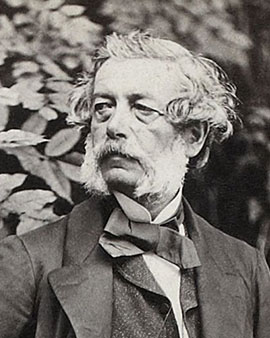The son of a craftsman, he was trained at an early age in the workshop of a copper engraver and then attended the Academy of Fine Arts in Munich. Travels to Italy followed, where he studied the Venetian school of painting in particular. Soon after, he was drawn to Paris, the city where the first portraits of emperors and kings were created.
Enthused by Winterhalter's virtuosity, Napoleon III provided him with a studio in the Tuilleries.
The path to becoming a portraitist reached its peak with the paintings of Empress Sisi of Austria. In the meantime, he had risen to become the most famous German portrait painter, and Emperor Franz of Austria commissioned the painter to create a picture of the empress. It was to be a personal, intimate work, not intended for the eyes of the public. A little earlier, he had already produced a representative portrait of Sisi and her husband for the public.
Now a work was to be created for the eyes of the emperor only.
The portrait shows the beautiful, universally beloved empress with loose hair in delicate silky, loosely draped, robe. It should decorate the study of the emperor.
Word had spread everywhere about how flattering and lovely the painter was able to depict women in particular. The commissions reached such a high number that they were often too much for Winterhalter alone to handle. He therefore had his brother Hermann, who worked in his studio, make at least the copies that were customary for state portraits.
×





 Surrounded by her Ladies-in-Waiting 1855 - (MeisterDrucke-100747).jpg)
 Surrounded by her Ladies-in-Waiting 1855 - (MeisterDrucke-100747).jpg)
 Empress of Austria wife of Emperor Franz Joseph of Austria (1830-1916) - (MeisterDrucke-40226).jpg)
 Empress of Austria wife of Emperor Franz Joseph of Austria (1830-1916) - (MeisterDrucke-40226).jpg)
 nee Varvara Dmitrievna Mergassov 1864 - (MeisterDrucke-72813).jpg)
 nee Varvara Dmitrievna Mergassov 1864 - (MeisterDrucke-72813).jpg)
.jpg)
.jpg)
 wife of Emperor Franz Joseph I of Austria (1830-1916) - (MeisterDrucke-50873).jpg)
 wife of Emperor Franz Joseph I of Austria (1830-1916) - (MeisterDrucke-50873).jpg)
.jpg)
.jpg)
.jpg)
.jpg)
.jpg)
.jpg)
_(sissi)_Imperator_of_Austria_(1_-_(MeisterDrucke-1034919).jpg)
_(sissi)_Imperator_of_Austria_(1_-_(MeisterDrucke-1034919).jpg)
.jpg)
.jpg)
 1859 - (MeisterDrucke-204282).jpg)
 1859 - (MeisterDrucke-204282).jpg)
 wearing the dress uniform of an Austrian Field Marshal with the Great Star of the Military Order of Maria Theresa 1864 - (MeisterDrucke-71829).jpg)
 wearing the dress uniform of an Austrian Field Marshal with the Great Star of the Military Order of Maria Theresa 1864 - (MeisterDrucke-71829).jpg)
.jpg)
.jpg)
.jpg)
.jpg)
.jpg)
.jpg)
.jpg)
.jpg)
.jpg)
.jpg)
.jpg)
.jpg)
.jpg)
.jpg)
.jpg)
.jpg)
.jpg)
.jpg)
.jpg)
.jpg)
.jpg)
.jpg)
.jpg)
.jpg)
.jpg)
.jpg)
_Painting_-_(MeisterDrucke-983958).jpg)
_Painting_-_(MeisterDrucke-983958).jpg)
.jpg)
.jpg)
.jpg)
.jpg)
.jpg)
.jpg)
.jpg)
.jpg)
.jpg)
.jpg)
_Painting_by_Franz_Xaver_W_-_(MeisterDrucke-988153).jpg)
_Painting_by_Franz_Xaver_W_-_(MeisterDrucke-988153).jpg)
.jpg)
.jpg)
_in_1855_surrounds_the_ladies_of_honor_of_the_Det_-_(MeisterDrucke-1029499).jpg)
_in_1855_surrounds_the_ladies_of_honor_of_the_Det_-_(MeisterDrucke-1029499).jpg)
.jpg)
.jpg)
.jpg)
.jpg)
 wife of Napoleon Bonaparte III (1808-73) - (MeisterDrucke-71091).jpg)
 wife of Napoleon Bonaparte III (1808-73) - (MeisterDrucke-71091).jpg)
 and Prince Albert (1819-61) with - (MeisterDrucke-285424).jpg)
 and Prince Albert (1819-61) with - (MeisterDrucke-285424).jpg)
_(sissi_ou_sisi)_imperatrice_dAu_-_(MeisterDrucke-1318301).jpg)
_(sissi_ou_sisi)_imperatrice_dAu_-_(MeisterDrucke-1318301).jpg)
_(1833-1878)_Painti_-_(MeisterDrucke-960537).jpg)
_(1833-1878)_Painti_-_(MeisterDrucke-960537).jpg)
.jpg)
.jpg)
_(sissi)_Imperator_of_Austria_(1_-_(MeisterDrucke-946232).jpg)
_(sissi)_Imperator_of_Austria_(1_-_(MeisterDrucke-946232).jpg)
.jpg)
.jpg)
.jpg)
.jpg)
.jpg)
.jpg)
.jpg)
.jpg)
.jpg)
.jpg)
.jpg)
.jpg)
_c1852_(oil_on_canvas)_-_(MeisterDrucke-1092670).jpg)
_c1852_(oil_on_canvas)_-_(MeisterDrucke-1092670).jpg)
.jpg)
.jpg)
 1842 - (MeisterDrucke-44868).jpg)
 1842 - (MeisterDrucke-44868).jpg)
.jpg)
.jpg)
.jpg)
.jpg)
.jpg)
.jpg)
.jpg)
.jpg)
.jpg)
.jpg)
.jpg)
.jpg)
.jpg)
.jpg)
_Painting_by_Francois_Xaver_Winterhalte_-_(MeisterDrucke-969894).jpg)
_Painting_by_Francois_Xaver_Winterhalte_-_(MeisterDrucke-969894).jpg)
.jpg)
.jpg)
_Composition_inspire_par_le_recueil_de_nouvelles_de_-_(MeisterDrucke-1320272).jpg)
_Composition_inspire_par_le_recueil_de_nouvelles_de_-_(MeisterDrucke-1320272).jpg)
.jpg)
.jpg)
.jpg)
.jpg)
.jpg)
.jpg)
 Emperor of France - (MeisterDrucke-60400).jpg)
 Emperor of France - (MeisterDrucke-60400).jpg)
.jpg)
.jpg)
_1842_-_(MeisterDrucke-546948).jpg)
_1842_-_(MeisterDrucke-546948).jpg)
.jpg)
.jpg)
.jpg)
.jpg)
.jpg)
.jpg)
 1844 - (MeisterDrucke-83625).jpg)
 1844 - (MeisterDrucke-83625).jpg)
.jpg)
.jpg)
.jpg)
.jpg)
.jpg)
.jpg)
.jpg)
.jpg)
.jpg)
.jpg)
.jpg)
.jpg)
 1859 - (MeisterDrucke-232623).jpg)
 1859 - (MeisterDrucke-232623).jpg)
.jpg)
.jpg)
.jpg)
.jpg)
.jpg)
.jpg)
.jpg)
.jpg)
_and_her_Ladies_in_Waiting_detail_of_the_Princess_of_-_(MeisterDrucke-86595).jpg)
_and_her_Ladies_in_Waiting_detail_of_the_Princess_of_-_(MeisterDrucke-86595).jpg)
.jpg)
.jpg)
.jpg)
.jpg)
.jpg)
.jpg)
.jpg)
.jpg)
 - (MeisterDrucke-111644).jpg)
 - (MeisterDrucke-111644).jpg)
_-_(MeisterDrucke-1089077).jpg)
_-_(MeisterDrucke-1089077).jpg)
.jpg)
.jpg)
.jpg)
.jpg)
.jpg)
.jpg)
.jpg)
.jpg)
.jpg)
.jpg)
.jpg)
.jpg)
.jpg)
.jpg)
 - (MeisterDrucke-25872).jpg)
 - (MeisterDrucke-25872).jpg)
.jpg)
.jpg)
.jpg)
.jpg)
_Painting_-_(MeisterDrucke-971196).jpg)
_Painting_-_(MeisterDrucke-971196).jpg)






